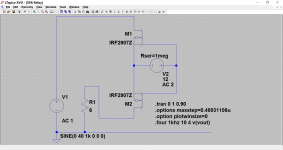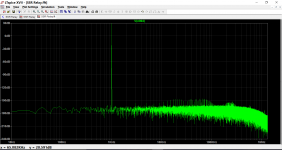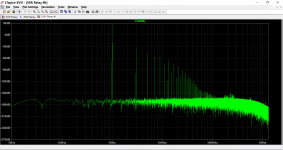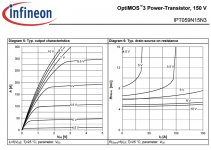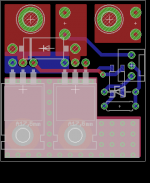Re: post #37
What is D2 for?
It is an optional part. It makes it easier to insert the circuit into a protection circuit expecting a relay of a particular voltage without changing too many parameters.
I haven't come across any measurements of distortion of a MOSFET in this position replacing a relay. Does anyone have a link? I'm sure it's low, but how low is the question.
Soooo...
Can this schematic be considered final ? I removed the unnecessary protection zener (the tlp3906 cannot generate enough voltage), added a connector with a pin for the +12v control line, gnd and sensing of the amplifier output and moved the tvs across the output's posts.
Not in my opinion. The problem with the TVS across the speakers is that the mosfets then are subject to double the voltage, which means the mosfets are larger and more expensive and with significant higher gate capacitance....
As just a relay replacement you don't need to care about protection of other parts in the amplifier, they should already have the protection the designer wants....
I haven't come across any measurements of distortion of a MOSFET in this position replacing a relay. Does anyone have a link? I'm sure it's low, but how low is the question.
The 'obvious' (or not so obvious) answer is that its totally FET dependent. A simulation using IRF240 vs IRF2907 is revealing. A FET that has a largish value for Rds would also show some form of AM distortion as the voltage across the FET's would be current dependent.
It would be good to see an actual measurement though.
This is a voltage of 28 vrms (so 100watts into 8 ohms) being applied across a 6 ohm load (so a little tougher).
Attachments
120dB of extra distortion.
Can the high Rds on make that much of a difference?
Or is some of that down to different models used by the simulator?
What if one just put some extra resistance in the line to see the resistance effect?
Can the high Rds on make that much of a difference?
Or is some of that down to different models used by the simulator?
What if one just put some extra resistance in the line to see the resistance effect?
120dB of extra distortion.
Can the high Rds on make that much of a difference?
Or is some of that down to different models used by the simulator?
What if one just put some extra resistance in the line to see the resistance effect?
Mosfets have a very linear Id/Vds curve up to a certain current, once you reach that current it stops being linear, take a look at any mosfet datasheet. The IRF240 is a small old mosfet and stops way before the IRF2907....
Are you saying it's the mosFET models that are causing this big difference in distortion and that the models are correct.
Whereas if it had only been a difference in Rds on (resistance) we would see a much smaller distortion difference.
Whereas if it had only been a difference in Rds on (resistance) we would see a much smaller distortion difference.
hi,00940
any particular reason u selected tlp3906?
i was advised by member paulbysouth to use vishay VOM1271, it is cheaper(1 usd) with very fast turn off time 25 micro second compared to 300 micro second of tlp 3906, just got the board , just check spec
any particular reason u selected tlp3906?
i was advised by member paulbysouth to use vishay VOM1271, it is cheaper(1 usd) with very fast turn off time 25 micro second compared to 300 micro second of tlp 3906, just got the board , just check spec
Below are the diagrams of output characteristics and of the Rds(on) from the datasheet of the 150V/155A/5mOhm IPT059N15N3. Note that in an audio power amplifier SSR application the device operates within quite a small region next to the origin in the output characteristics diagram (assuming 0-25A current), and that Rds(on) stays almost independent of Id when Vgs is kept reasonably high making the device hard-on, by the diagram of Rds(on). They also tell that keeping the Vgs noise free, or the LED drive current in the voltaic coupler constant helps the Rds(on) remain constant. I wish I had a spice model of this device and could take it to a simulation.
Attachments
hi,00940
any particular reason u selected tlp3906?
i was advised by member paulbysouth to use vishay VOM1271, it is cheaper(1 usd) with very fast turn off time 25 micro second compared to 300 micro second of tlp 3906, just got the board , just check spec
Availability mostly to be honest. And the tlp3906 is actually cheaper than the vishay at mouser.
They are very similar output voltage wise. The tlp can provide a bit more current but that's mostly irrelevant. The vishay switches off faster but that's no big deal. It's still faster than a mechanical relay. And the 24µs for the vishay is given for a 200p load. The 300µs of the tlp3906 is into a 1000p load. So the differences in practice might not be that big.
And anyway, from the pinout and land pattern, they seem interchangeable.
Any progress here?Final board. Went back to the tvs across the mosfets. Still, it would be very easy to wire a tvs across the binding posts.
Eagle files attached (untested at this point but that's a very simple board, check for yourself).
- Status
- Not open for further replies.
- Home
- Amplifiers
- Solid State
- Mosfet-based replacement for loudspeakers relays
